|
RoboCop is one of a select group of films that occupies a significant place in my viewing history. This was the first press screening I ever attended, although not as a journalist or film reviewer. Allow me to explain.
When the upcoming UK release of RoboCop was announced at the tail end of 1987, all I had to go on were a few positive comments from across the pond and some intriguing stills. I knew next to nothing about the story, I had seen none of Dutch director Paul Verhoeven's previous work (boy, would that change in the years that followed), and I wasn't yet familiar with its leading man, Peter Weller. The only member of the main cast whose name I instantly recognised was that of Nancy Allen, and the last film I'd seen her in was her former partner Brian De Palma's Blow Out, a solid and inventive thriller in which she was, well, OK I guess. I still have issues with the claim made by John Travolta's character that she had a great scream. Anyway, a competition then appeared in one of the film magazines or trade papers that I read back then, one offering readers the chance to attend an advance screening at a London cinema. Just cut out the entry form, probably answer some question or other (can't remember, sorry) and post it in. Names would be pulled out of a bag and sent tickets to attend the aforementioned screening if they won. I did not win. Then again, I didn't expect to, as I have no doubt there were thousands of entries and only a few available seats. The very next day I received a call from a friend of mine. "Did you win?" he asked me. I told him that I hadn't. "I did," he responded. "They've sent me two tickets. Want to come along?"
If I remember right, the screening took place at the Odeon Leicester Square at some ungodly hour of the morning. This required us to get up before it was light and catch one of the first trains of the day, but we made it in good time and queued up with what we presumed were the other lucky winners. Many of them were, but there were others who just didn't seem to fit the bill, older and more studious-looking individuals plus a sprinkling of comically out-of-place luvvies who greeted each other with cries of "oh dahling!" and overly theatrical kisses on both cheeks. I like to think these people were traumatised by what they saw and ended up in therapy for years to come.
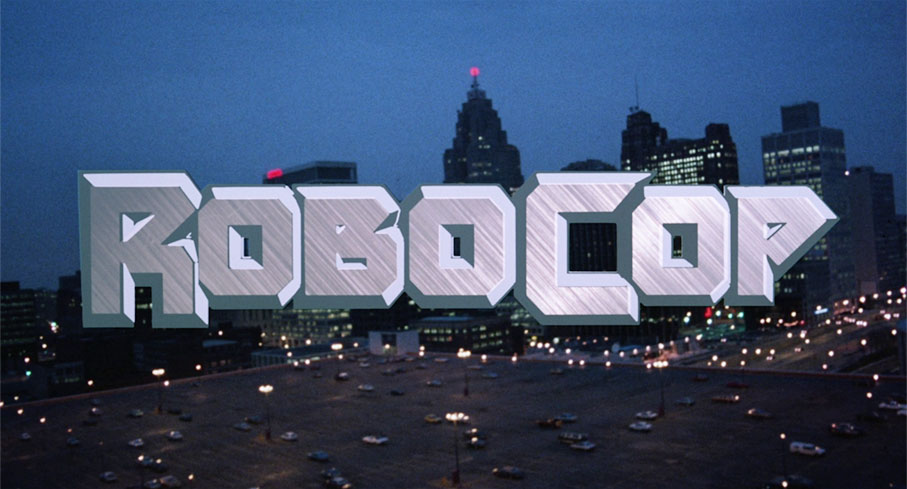
Two hours later my friend and I emerged from the cinema and...well...what do you think? You've seen it, haven't you? If you somehow haven't then I'd proceed with caution, as there are going to be spoilers ahead including a brief discussion of the ending. If you have seen it then there's a good chance you loved it as much as we did, and if you did, then read on to see if we are in agreement about why. If you merely liked it or weren't too sure, then maybe, just maybe I can convince you to take another look at what for me remains one of the best and smartest science-fiction action films yet to hit cinema screens anywhere.
For those few who've never seen then film and have decided to stay with me, a little plot might be in order. In a near-future Detroit, a beleaguered police force is doing increasingly desperate battle with an out-of-control level of violent crime, a situation not helped by budget cuts enforced by Omni Consumer Products, the private corporation that now runs the police force. At an OCP executive meeting, Senior Vice President Dick Jones (Ronny Cox) demonstrates his team's latest project, a militaristic law enforcement robot named ED-209. Unfortunately for Jones, ED-209 malfunctions and annihilates one of the executives in a hail of cannon fire, a disaster that ambitious executive Bob Morton (Miguel Ferrer) takes advantage of by pitching his own idea for man-machine hybrid named RoboCop to the disappointed OCP President (Dan O'Herlihy). To the consternation of Jones, the President gives the go-ahead to Morton's project, and his team begins looking for a suitable subject. Enter officer Alex Murphy, freshly transferred to the district and promptly partnered with the ass-kicking Anne Lewis. They haven't been on the street long before they find themselves chasing a violent gang led by the sociopathic Clarence Boddicker, one that concludes at a deserted steel plant, where Murphy is ambushed and shot to pieces by Boddicker and his men. He is rushed to hospital, but despite the best efforts of the medical staff he is declared dead and is quickly shipped off to Morton and his team, who set about transforming the broken Murphy into the cybernetic RoboCop.
OK, it's a neat setup, but what is it exactly that makes RoboCop so special? Well, let's start with its credentials as an action-orientated science fiction movie, which if you went by the trailers on this disc you'd likely believe that's all the film is. Indeed, to the uninitiated my outline above must sound like the plot of a lively low-budget independent B-movie in the mould of Charles Band's 1984 Trancers, an impression seemingly cemented by the presence of former New World producer Jon Davison in the executive producer's chair. But hold on a second. Yes, Davison first made his name working with Roger Corman on the likes of Big Bad Mama and Piranha – both of which are great fun – but crucially then went on to produce the Zucker Brothers' smash hit Airplane! and Sam Fuller's superb but confrontational White Dog. He clearly had an eye for a prestige project, and as the special features on this disc make clear, his enthusiasm for the screenplay by newcomers Ed Neumeier and Michael Miner and his determination to hire the best people possible in every department, helped to transform this potential B-movie into a film that, in spite of its modest budget, looks every inch a major studio production. And the team that came together here both behind and in front of the camera is, in retrospect, a small miracle of savvy judgement and good fortune.

The hiring of Dutch director Paul Verhoeven was a masterstroke. Verhoeven had by then already made his name on home turf as a director of offbeat and largely adult-oriented dramas, but had since made the English language Flesh+Blood, a distinctly non-Hollywood medieval adventure tale starring Rutger Hauer (by then a Verhoeven regular) and Jennifer Jason Leigh. Chance still played a part here, with Verhoeven famously tossing the script away in disdain after reading little more than the title and the proposed tagline, but then being persuaded to give it a second look by his wife Martine, who read it and quickly recognised its potential. Verhoeven was likely responsible for the hiring of acclaimed German cinematographer Jost Vacano, with whom he had worked on Soldier of Orange and Spetters (and who also shot Das Boot for Wolfgang Petersen if you're looking for credentials). A hugely talent effects team was assembled that included matte painter Rocco Gioffre (Star Trek – The Motion Picture, Blue Thunder, Gremlins), special photographic effects artist Peter Kuran (The Thing, Dreamscape, Return of the Jedi) and stop-motion animation wizard Phil Tippett (Star Wars, Dragonslayer, Indiana Jones and the Temple of Doom). And brought in to score the film was Basil Poledouris, a composer with a solid track record in creating music for action-adventure films and with whom Verhoeven had worked previously on Flesh+Blood.
As Murphy, Verhoeven cast Peter Weller, a relative unknown whose primary claim to fame at the time was his role as the title character in W.D. Richter's cult favourite The Adventures of Buckaroo Banzai Across the 8th Dimension, which I confess to not having seen when I walked into my first screening of RoboCop. He was partnered with Nancy Allen, who by shortening her hair to de-sexualise her character ended up making Lewis seem almost as cute as she is hard-as-nails tough. Crucially, care was also taken with the casting of even the smallest role, and the quality of the script made it easy to attract character actors of real talent. Performers genuinely wanted to be in this movie, and one of the real pleasures of the special features was discovering how highly they all still regard this film and their work in it.
Setting the story just a few years from now (a trick also used by George Miller for Mad Max) allowed Verhoeven and his crew to shoot on location, primarily in Dallas, and create a convincing sense of a dystopian near future with minimal resources. The use of in situ featureless concrete walls and cold, impersonal corporate facades (some of which have been extended upwards and outwards by Rocco Gioffre's extraordinary matte work) have a persuasive air of realism, and this small temporal shift allows for police uniforms, protective gear and vehicles to look similar to those we know today without feeling in any way incongruous. ED-209, on the other hand, is an astonishing futuristic creation, a terrifyingly convincing blend of hydraulics, robotics and military-grade assault hardware that plays on our innate fear of humans being replaced by self-aware technology that we can't help but suspect could malfunction and run wild in potentially lethal ways. Everything about it is imposingly aggressive, from the earth-shaking stomp of its on-haunches walk to the predatory animalistic snarls that underscore the cold bark of its deeply-voiced commands.
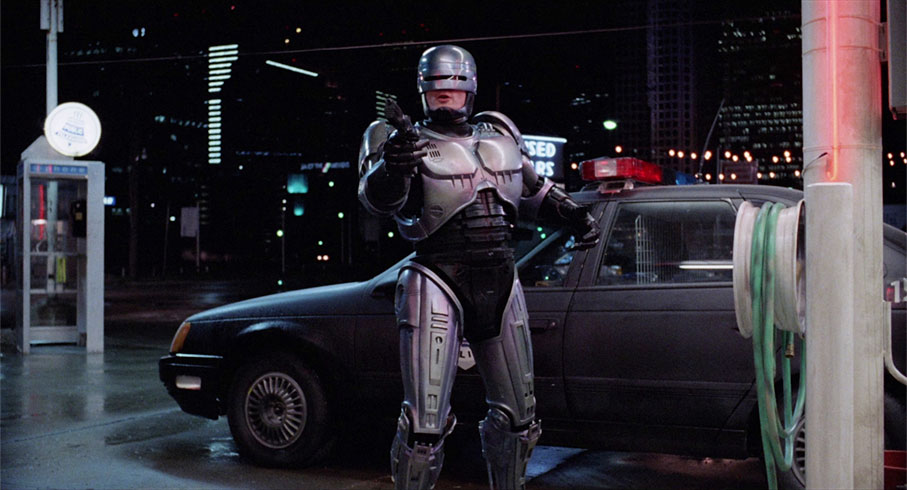
RoboCop himself is similarly imposing, his armoured suit having the bulk of an American football player padded out to the max with steel plating while his footsteps have the deep bass heft of an industrial machine on a search-and-destroy mission. His helmet and tinted visor robs him of any clear emotional response and adds to his cybernetic coldness, and while I've seen criticism of the fact that the lower half of his face remains exposed and thus vulnerable, I'd argue that there are sound reasons for this. When the helmet is later removed it seems clear that Murphy's head is now as metallic as his body and that his face has been removed and grafted onto this cybernetic skull. This suggests that while bullets might damage the skin, they would bounce off the underlying structure as readily as they do off of his chest. But why leave just that part of the face exposed? Well, think about it for a second. This is the only part of the original Murphy that remains visible once he is transformed into RoboCop, and it thus remains our sole connection to the man he once was – cover his face completely and he's no longer Murphy in a RoboCop suit but a featureless cyborg. But this also applies to how the character would be perceived within the film. RoboCop is designed to be the future of law enforcement, and the very thing that theoretically makes him a better choice to police the streets and interact with the public than ED-209 is that he still looks and moves in a manner that those he has pledged to protect and serve would recognise as human. When ED-209 speaks, it's in a synthetic voice that booms out through a speaker grill that sits between two machine guns, but when RoboCop does likewise we see him deliver his words as we would, a clear sign that there's still a person lurking somewhere beneath his armour. ED-209 is a hellish militaristic vision, while the RoboCop suit is effectively an extension of the riot gear that police already have at their disposal and that we, if only through news broadcasts, are already familiar with.
All of which would count for nothing if the film plodded witlessly and ineffectively along a predictable narrative path, tossing empty action sequences at us on its travels, but from the moment the camera flies through the metallic opening title we're given sly assurance that this film is to be nothing of the sort. What I wasn't ready for on that first viewing, and what none of the trailers and TV spots on this disc acknowledge, is how seamlessly and inventively the narrative unfolds, how brutal and purposeful the violence is, and how wittily satirical it manages to be, in a manner that – like the political subtext of Rollerball before it – was so forward-looking that it has even more relevance today than it did on its release. One of the fun factors of the satirical elements is that we don't immediately realise we're meant to read them as such. And they come early. The film opens with a televised media break, complete with plinky-plinky theme music, old school digital video effects and over-groomed and over-cheerful male and female hosts. Their first story warns of potential atomic war in then still apartheid South Africa, but then switches on a smile to a light-hearted piece about power failure triggering unexpected weightlessness on the "Star Wars Orbiting Peace Platform," (a reference to Ronald Reagan's planned – and frankly preposterous – Strategic Defence initiative). A wincingly cheesy commercial for a new artificial heart that feels styled on actual American medical service commercials of the day and the closing story about critically injured police officer Frank Frederickson that ends with an upbeat, "Good luck, Frank!" are both just tacky enough to make you unsure whether any laughter on our part was intended. Go back to this after even a single viewing and you'll be in no doubt, but you'll also become aware of just how much scene-setting information we were being fed in the guise of satirical comedy. In the space of just a few seconds of screen time we learn that crime is running riot in Old Detroit, that the contract to run and fund the city's police force has been awarded to Omni Consumer Products, and that Clarence Boddicker is dangerous and powerful criminal who is responsible for the deaths of a whole string of policemen. We're also introduced to OCP executive Dick Jones, who in a brief televised interview makes it clear that he has about as much sympathy for front line cops as Boris Johnson does for anyone who wasn't educated at Eton.
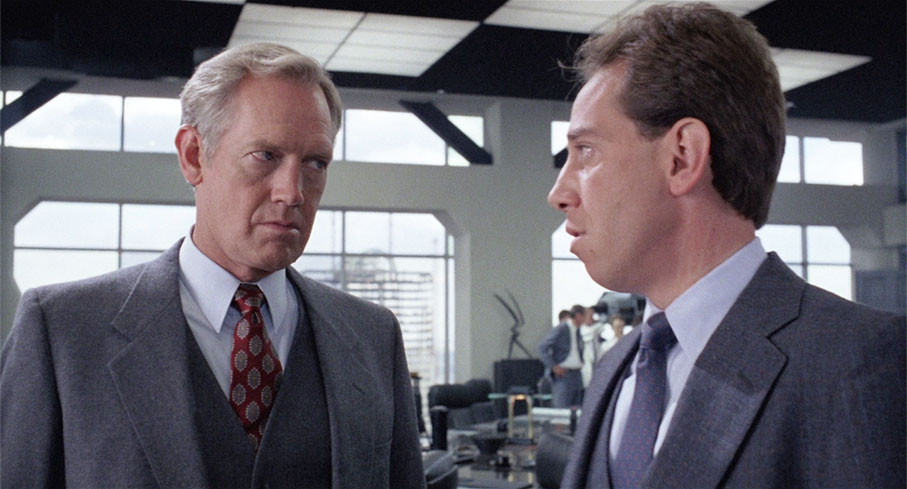
The fluidity of the storytelling is remarkable throughout but so deftly executed that it takes a few viewings to really appreciate it. Scenes dovetail seamlessly and logically into each other in a way that keeps the story moving at a considerable lick but that on re-examination is a masterclass in cinematic narrative construction. A perfect example comes at the tail end of RoboCop's first night on the job (I can't be the only one who experienced a flashback to Superman's first night out from Richard Donner's 1978 movie in this sequence), which ends with RoboCop punching disgruntled former city councilman Ron Miller, who was holding the mayor hostage, through an upstairs window and down into the street. The scene ends on a comic note as a whole fleet of perfectly synchronised TV cameras tilt down rapidly in time with Miller's plummeting, then we cut to the news broadcast on which the footage shot by one of these cameras is being shown and discussed. Again the tone is light-hearted and this time is interrupted for a cheery commercial for a family-oriented nuclear war board game ("Get them before they get you!"). Even footage of RoboCop visiting a school is played partly for laughs when his message to all the kids watching is the grimly emotion-free advice to "stay out of trouble." The news story ends with an interview with Bob Morton, who signs off with the warning to criminals that "there's a new guy in town, his name's RoboCop." And in the very next scene we're at OCP headquarters and Morton is walking out of the very interview we've just seen broadcast, being congratulated by a colleague and unknowingly heading to a bathroom confrontation with Dick Jones that is set to seal his fate.
Even by today's standards, the violence is pushed to sometimes comic-book extremes (extremes that led to censorship cuts for the film's cinema release), but the two most prominent early film examples both have specific narrative functions. The boardroom slaughter of hapless executive Mr. Kinny not only sets the tone for the violence to come and makes plain just how catastrophic to society a malfunctioning ED-209 would be, but establishes at an early stage how formidable an opponent it will prove to be when Murphy inevitably has to do battle against it. The graphic destruction of Murphy's hand and the hail of gunfire that robs him of his arm and ultimately his life serve a dual purpose. Firstly, it leaves us in no doubt that his body is wrecked beyond natural repair and that he thus would indeed be a prime candidate for the RoboCop programme. Secondly, it confirms that Boddicker and his boys have absolutely no humanity and are capable of anything, and that any attempt to reason with them would be a waste of breath. This has echoes in the POV sequence in which Murphy intermittently comes round to catch snippets of Morton's team at work, where Morton is shown to have a similar lack of empathy for Murphy. When a member of the team reveals that they were able to save Murphy's left arm, Morton is unhappy. "I thought we agreed to total body prosthesis," he snaps, followed by, "lose the arm." By the time we get to the incredible melting Emil, the comic-book tone has been well and truly established and Verhoeven just seems to be having fun with the horror (this also leads to an ultra-violent gag that had audiences whooping with dark delight at preview screenings).
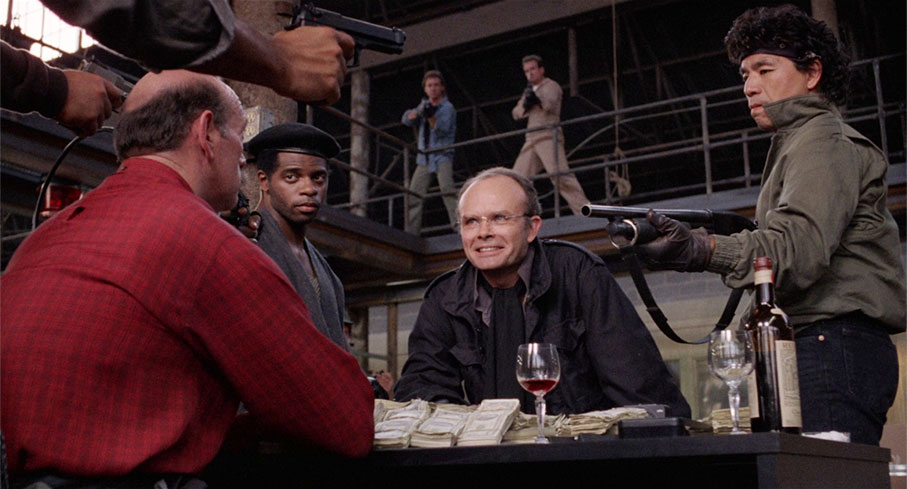
The casting, as I noted above, is spot-on across the board, with so much attention paid to getting even the bit parts right that there's not the smallest weak link anywhere here. The chisel-cheeked and bright-eyed Weller brings a likeable gravitas to Murphy that makes bonding with him easy, essential given how quickly he meets his fate (and Weller really makes us feel his suffering here). Once in the RoboCop suit he works wonders using only his mouth and chin, and if you're looking for proof, just rerun what for many is the film's most emotionally affecting scene, when Murphy returns to his former family home and finds his wife and kids gone and the house up for sale. His transformation from a man looking to recover lost memories to one furious at what he has become is all communicated through what Weller does with his mouth and body movements. Nancy Allen was not someone I'd have thought of casting as Lewis at the time, but her selection was inspired and I would argue that this is her finest film role to date. Here she communicates as much through looks and glances as she does through dialogue, from her realisation that RoboCop may actually be Murphy based on his trait of spinning his gun before holstering it in the manner of TV cop T.J. Lazer (a reference to the William Shatner police show, T.J. Hooker), to her impressively controlled (almost non-) response to seeing the transformed Murphy without his helmet for the first time. All three of the lead executives are superbly played. Veteran actor Dan O'Herlihy has the appropriate status and command at the company President known only as The Old Man, Ronny Cox is wonderfully cast against type as his utterly corrupt and sociopathic second-in-command Dick Jones, and in the role that first brought him to widespread prominence, Miguel Ferrer is a furious ball of arrogant energy as the obsessive and ambitious Bob Morton. They're matched – and possibly even outstripped – by Kurtwood Smith's glorious turn as Clarence Boddicker, who with his nasal drawl, his steel-rimmed glasses and his cocky but lethal self-confidence may just be the most memorable villain in all 80s American cinema, as well as the most enjoyable to watch. Much of this is down to Smith's knack for inventive improvisation and the room Verhoeven was willing to give him to experiment on this front. This resulted in him throwing in lines that have become fan favourites ("Ooo, guns, guns guns!") and spitting blood onto police paperwork on his eventual arrest, a move that none of his fellow actors were aware was coming (and it shows and absolutely works for the scene).
As an action thriller, RoboCop never puts a foot wrong, with every sequence driving the story forward and yet always memorable and distinctive on their own terms, making it genuinely hard to list favourite scenes without continually want to change your picks. Neumeier and Miner's screenplay is a marvel, not just in the smartness of its dialogue, its unexpected plot turns and its structural sophistication, but in the way that it balances its science fiction thriller core with its comically satirical elements and its socio-political subtext. It's a formula that director Verhoeven energetically responds to, and can be seen again in full flow in his later collaboration with screenwriter Neumeier on Starship Troopers, which boasts a similarly harmonious blend of future-set head-on satire and breathless action. It also looks bloody marvellous (especially on this disc), both in Jost Vacano's cinematography and William Sandell's production design, and can there be any fan of the film who doesn't have Basil Poledouris's triumphant main theme with its industrial hammer-on-anvil clangs permanently embedded in a corner of their brain?
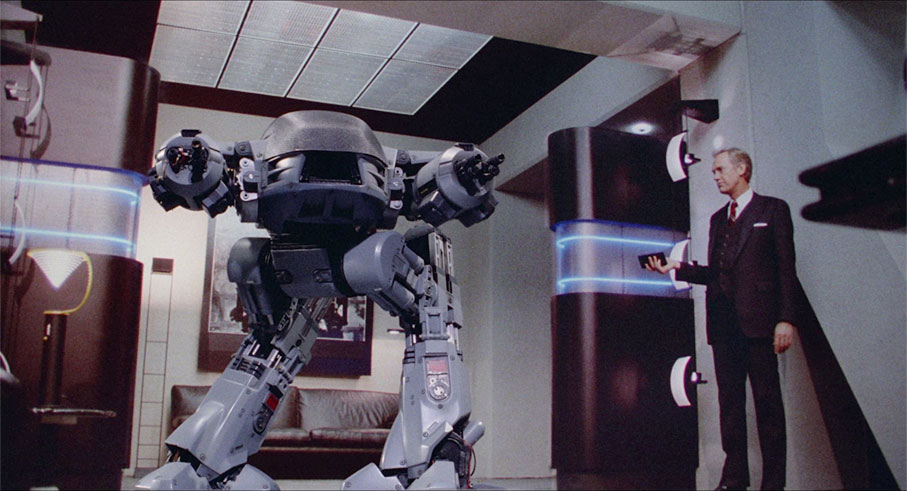
It's difficult to know where to stop with RoboCop, as every scene, every character and seemingly every line of dialogue is worthy of detailed discussion and analysis. There's a timeless quality to the action and the visuals that have ensured it hasn't dated a jot, and as I previously intimated, the film's socio-political subtext is even more relevant now than it was on its release. Its depiction of a desperate police force fighting for survival against budget cuts imposed by the greedy and feckless private corporation that now runs it cuts a little too close to the bone, particularly at a time when documented proof has been provided that our government of lying and immoral profiteers is planning to hand our health service over to the very type of American corporations that would rub their disgusting hands together with glee at the prospect of an ED-209 style robot in a surgical mask. That Boddicker should be revealed to be working directly with Dick Jones should not come as a surprise, and it's telling that the scene in which this is confirmed is not played as a shock revelation. Both men are two sides of the same coin and make for an ultimately lethal combination, one willing to do anything for money and the other with the money to convince him to do it, whatever the impact on society at large. Remind you of anyone? It bloody will soon if you don't get out and vote against the awful bastard. Woven into this mix are explorations of identity and ownership of the self, plus the notion that who we are is increasingly defined by the company or corporation for whom we work, raising questions about whether we are considered by them as individuals or as disposable property.
Ultimately, of course, what made RoboCop such a hit with audiences back in 1987 and continues to make it so popular today is how blisteringly good it is as entertainment. But it's important to recognise that the satire is not just an added bonus to an already strong science-fiction thriller narrative but an integral part of why that narrative works as well as it does. Verhoeven's almost obsessive attention to detail also helps to texture scenes in a manner that makes them individually memorable, a trait that his collaborators all seem to have shared, something evident in what ED-209 animator Phil Tippett does with the notion that a machine that large and deadly could be confused and disabled by something as simple as stairs. It's just one amazing moment in a film that bristles with them. RoboCop is a close-to-perfect genre B-movie executed with A-movie polish and class, a beautifully crafted jigsaw whose pieces all connect without a hint of resistance and that are each in some way memorable in their own right. Indeed, I only have one small gripe with the film as it stands (bail out fast if you've not seen it), and that's despite its seemingly triumphant ending, one of the key villains of the piece essentially escapes unpunished. As the movie concludes with Murphy reaffirming his identity and earning the respect of The Old Man, OCP remains in charge of a beleaguered police force whose members are still on strike to protest at the corporation's budget cuts and lethal working conditions. As the extra features reveal, the original ending did see OCP give in to the strikers' demands, but I can't help thinking that a truly happy conclusion would have seen the company broken up, its executives jailed, and the Detroit Police brought back under public control, where their conditions would be met and the service properly funded. I can but dream.
There are a number of serious omissions in my already insanely large disc collection. One of them is RoboCop, which despite being one of my favourite films (could you tell?), I've never got around to buying on Blu-ray. Indeed, the only version I have is the aforementioned Criterion DVD from 1998, and while this contained the Director's Cut and had a transfer that was up to the usual Criterion standard, it was framed 1.66:1 and letterboxed with no anamorphic enhancement. On the TV I had then it looked fine but on my current, considerably larger HD screen, it definitely struggles. I've since watched an HD download of the film and that looked good, but both that and the DVD were absolutely blown away by the utterly gorgeous restoration and transfer on this new Arrow Blu-ray. This really is a pristine presentation in every respect. The image is sharp, with crisp rendering of fine detail, the contrast spread is gorgeous with solid blacks and good shadow detail, and the colour feels authentic to the original projection print, with a lovely cool hue to the blues and vibrant rendering of brighter colours, such as the vivid reds of the nightclub scene. Jost Vacano's cinematography looks beautiful here, and there's not a hint of damage or dirt to blight those cleanly rendered concrete greys. Superb.
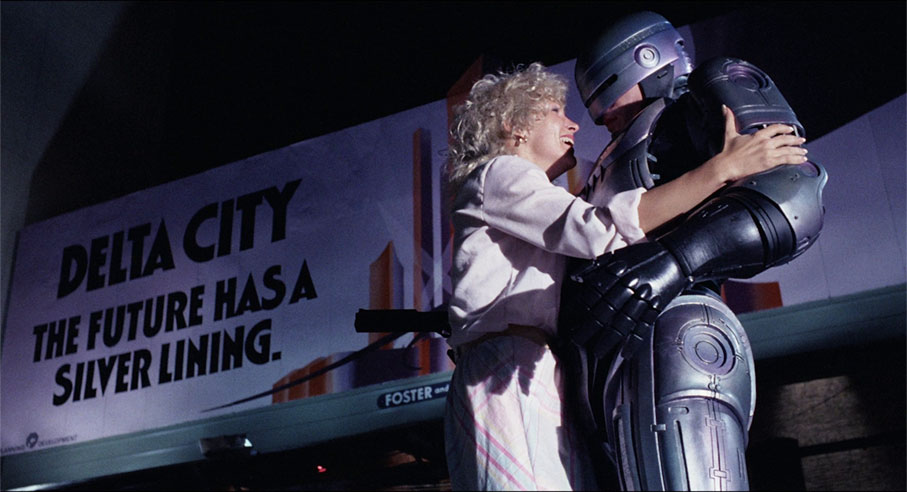
Three audio options are available, stereo 2.0, surround 4.0 (which I believe was the original surround option) and surround 5.1, all as DTS-HD Master Audio tracks. All three are in excellent shape, with crisp reproduction of music, dialogue and effects. There's a little more spread on the surround tracks, with music and some effects making their way to the back of the room, and the bass thump of Robo's footsteps has a tad more bass punch on the 5.1, though the music in the nightclub was not as thumpingly loud or bass driven as I was expecting on any of the tracks.
Optional English subtitles for the deaf and hard of hearing are available.
DISC 1: DIRECTOR'S CUT
Commentary with Paul Verhoeven, Jon Davison and Ed Neumeier
Recorded in 2001 and re-edited in 2014 for the director's cut of the film (that's this one), this commentary with director Paul Verhoeven, producer Jon Davison and co-screenwriter Ed Neumeier is a consistently lively delight, with Verhoeven and Neumeier so energetically animated that producer Davison – who is praised by just about everyone in the extra features – barely gets a word it. There's so much ground covered here, including information on the actors, the anti-corporate subtext, the RoboCop-as-Christ metaphor (you'll hear that a lot in the extras), the decision to make Lewis a non-sexualised character, who the principal cops and criminals are named after, the technical problems that came up when filming the drug den raid, and a whole lot more. Neumeier repeatedly praises Verhoeven's direction and Verhoeven in turn is complimentary about the work of his collaborators, and all three are bowled over by the actors and Phil Tippett's animation of ED-209. Having listened to this first, there are things I learned here that are repeated elsewhere (with this many extras, it's hardly surprising), but there are also stories and anecdotes about the shoot that are unique to this commentary.
Commentary with Paul M. Sammon
This second commentary is by Paul M. Sammon, who at the time of production was a marketing executive for Orion, was also part of the team that restored the director's cut of the film for its release by Criterion, and authored the excellent Future Noir: The Making of Blade Runner. He's a huge and still enthusiastic fan of the film and knows a great deal about its production, much of which he imparts here. We get info on the design concepts of ED-209, the Dallas locations, the film's critique of Reaganomics, the RoboCop suit, the influence of both Judge Dredd and Fritz Lang's Metropolis, the underlying themes and a load more. In a heartfelt closing shout of praise for the film, he notes that he worked on it, has seen it so many times and been interviewed about it, but has never tired of it and regards it as a "stone cold classic."

Commentary with Christopher Griffiths, Gary Smart and Eastwood Allen
I have to admit that I probably did the three gentlemen here a disservice by listening to their commentary after first watching all of the other special features on this disc, as by that point I had already heard many of the stories and snippets of trivia that they deliver several times from the mouths of others. This, essentially, is the RoboCop geek trivia and information track, and if that sounds condescending it's really not meant to – these three love this movie and not only have researched the hell out of every aspect of it, they've also talked to many of those involved in its production. Seriously, I can't imagine there's a question you could ask about even the most seemingly insignificant aspect of the film that they couldn't give you an insanely detailed answer to. It's this level of knowledge that ensures that even if you have watched all of the other extras first as I did (there are reasons why this happened), there's still going to be plenty that you won't have heard elsewhere. They also highlight a gag that should have been obvious to me that for some reason I'd never cottoned on to, a direct South Park reference involving ED-209's unfortunate boardroom victim, Mr. Kinny.
The Future of Law Enforcement: Creating RoboCop (16:51)
A newly filmed interview with co-writer Michael Miner, who recalls his early political activism and his concerns about what he perfectly summarises as predatory capitalism, and how he and Ed Neumeier met and teamed up to fashion their individual ideas into the first RoboCop screenplay. He reveals that both Fox and Columbia passed on the script but that Orion was more receptive to it and was known for giving filmmakers the time and space they needed to develop projects. He talks about Neumeier's involvement in the development of the look of the RoboCop suit, the casting of Peter Weller, the importance of the theme of identity, the difference between subjective and objective violence and his first viewing of the film in Times Square. There's plenty more to digest here, all worthwhile.
Robotalk (32:08)
A newly filmed roundtable discussion with co-writer Ed Neumeier and filmmakers David Birke, who wrote Elle for Paul Verhoeven, and Nicholas McCarthy, director of this year's The Prodigy. Both Birje and McCarthy are big fans of the film and are essentially there to prod Neumeier for information and stories about the production, chipping in to the replies with their own observations and views. It's here that I first heard the term "fascism for liberals," which was coined by producer Jon Davison to describe the film's tone, and while some things discussed here do get coverage elsewhere, they are related here from Neumeier's viewpoint and there's still a fair amount unique to this interview. It's a really enjoyable chat that seemed to fly by – I was convinced I was only about halfway through when it came to an unexpected end. I could have easily watched 30 minutes more of this.
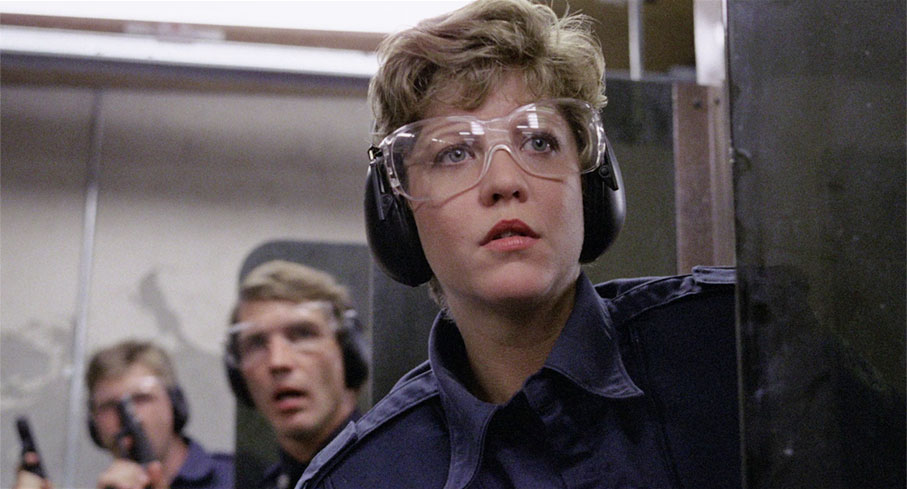
Truth of Character with Nancy Allen (18:26)
A newly shot and very welcome chat with actor Nancy Allen who, in common with all of the actors interviewed in the extras on this disc, still holds the film in extremely high regard. She admits to being hooked by a "close to perfect" script but thinking that it would never have broad appeal because it was too smart, and reveals that her character's signature bubblegum chewing and popping was right there on the page. Subjects covered include her character's hairstyle and lack of sexuality, the advantages to shooting on location, Verhoeven's habit of acting out every part, having to learn to fire a gun because she'd never even held one before despite the fact that her father was a cop, and much more. She also reveals that she passed on the Julie Haggerty role in Airplane! because it had three directors, and how could that possibly work? Ah...
Connecting the Shots with Mark Goldblatt (11:06)
A new interview with second unit director and frequent Verhoeven collaborator Mark Goldblatt, who recalls getting to know Jon Davison during his time at New World and bonding over their similar taste in films. Ain't that so often the way? This led to a chance meeting with Paul Verhoeven at a screening organised by Goldblatt of the European print of Ridley Scott's Legend (all three men were huge fans of composer Jerry Goldsmith, whose score was replaced for the film's American release), which ultimately led to him working for Verhoeven on RoboCop. He notes that his job was made easier by someone as meticulously well planned as Verhoeven but emphasises the freedom he gave him to do his own thing when shooting second unit material. By the time he worked on RoboCop he had already made his name as an editor (his CV on this score includes The Howling, Enter the Ninja and The Terminator) and later worked in that capacity for Verhoeven on Showgirls and Starship Troopers.
Analog with Peter Kuran and Kevin Kutchaver (13:10)
A new featurette in which special photographic effects artist Peter Kuran and animation effects artist Kevin Kutchaver recall becoming friends at an early age over their fascination with camera tricks and Ray Harryhausen movies. Kutchaver is one of many on this disc who took an instant liking to producer Jon Davison, whom he met on Piranha, and they both discuss specifics of the work they did on the film. I love the revelation that RoboCop's thermal vision was created by dressing performers in painted leotards, and they're on to something when they suggest that what's missing from modern CGI animation is the sense of individualism that people like Harryhausen and Phil Tippett brought to their work.
More Than a Machine: Composing RoboCop (12:04)
Also new is this featurette in which music experts Jeff Bond, Lukas Kendall, Daniel Schweiger and Robert Townson pay tribute to the late composer Basil Poledouris, whose score for RoboCop is so much part of the film's identity. It's suggested that Poledouris was particularly gifted at scoring movies about masculinity, and there's a really interesting deconstruction of the RoboCop score's themes and motifs and how it emphasises the action and characters and even the subtext.
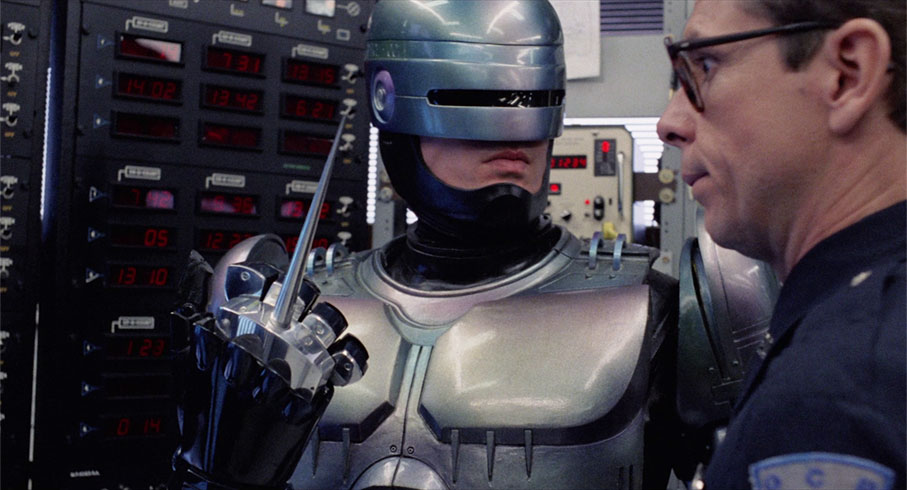
RoboProps (12:50)
A newly filmed tour of hardcore RoboCop fan Julien Dumont's collection of original props and memorabilia from the film, which includes his first ever unfolding of a wonderful, billboard-sized poster. There's a nice story about him buying and restoring a suit from RoboCop 2 only to discover that it was actually a prop from the first film, and he even has film reels of dailies and sound tests. Dumont's French accent is strong but his words are always easy to understand, so I didn't need the English subtitles that popped up as soon as he started speaking – pleasingly, they are optional and can be switched off.
2012 Q&A with the Filmmakers (42:37)
Captured on multi-camera video at UCLA, this on-stage discussion in front of an audience of film students features Paul Verhoeven, Peter Weller, Nancy Allen, Ed Neumeier, Michael Miner and Phil Tippett, and while it does cover a lot of the same ground as other special features on this disc, the relaxed nature of the conversation makes for entertaining viewing nonetheless. Verhoeven, Weller, Neumeier and Miner tend to dominate, though Tippett and Allen do get to chip in, but like the above-detailed roundtable discussion with Neumeier, I felt this could have gone on for at least another half-hour.
RoboCop: Creating a Legend (21:10)
One of several archive extras from 2007, this featurette on the making of the film inevitably covers ground you'll probably be familiar with if you're working your way through the extras in the order they are listed, but still includes content unique to this piece. Built around interviews with Jon Davison, Paul Weller, Ed Neumeier, Michael Miner, Paul Verhoeven, Paul Sammon, Kurtwood Smith, Miguel Ferrer and Ray Wise, it covers all of the essentials in engaging fashion, from the problems caused by the inflexibility of the RoboCop suit to Weller's initial method-actor insistence that he be called Murphy or Robo when on set, something Verhoeven found silly and Ferrer used as a way to take the piss. Unsurprisingly, it didn't last.
Villains of Old Detroit (17:00)
Another 2007 featurette constructed from different extracts from the interviews shot for the above featurette, though also including Ronny Cox, who relished the chance to play a villainous role after almost becoming typecast as a good guy. There's some choice stuff in here, with Ferrer describing the shoot as being like the best summer camp ever and the role of Bob Morton as deliciously avaricious and "like every Hollywood junior agent you've ever met." Wise, meanwhile, admits he wanted to play Boddicker but still liked the role he landed, in part because he was the best looking of the gang. He signs off memorably by revealing that he still has the tattered remnants of his blown-apart costume, which are "wrapped in plastic, like Laura Palmer was."
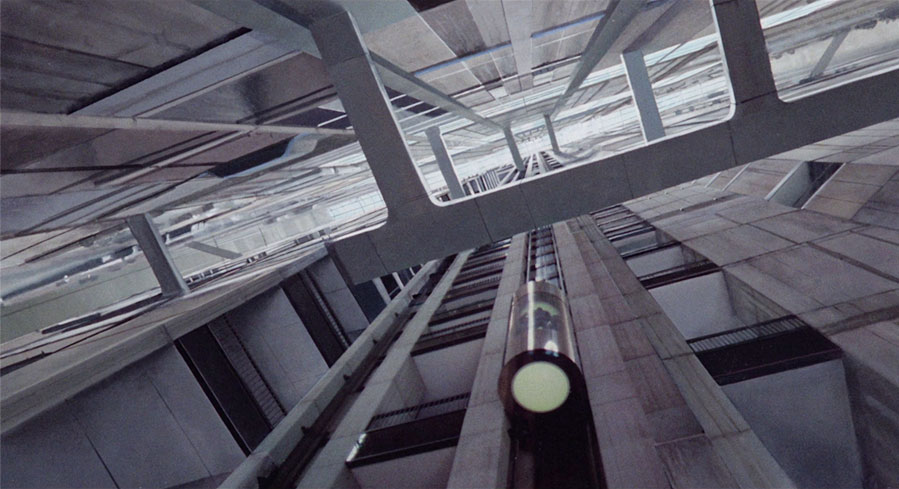
Special Effects: Then and Now (18:21)
The next 2007 featurette looks at the film's design and effects and is built around interviews with Paul Sammon, Paul Verhoeven, Phil Tippett, production designer William Sandell, ED-209 designer and constructor Craig Hayes and matte painter Rocco Gioffre. This is one seriously talented collection of people, and the detail they provide on their work on the film is utterly fascinating, none more so that matte painter Gioffre, whose work is so seamlessly matched to the live action elements that I'd challenge anyone who didn't know this was matte work to identify what was real and what was painted. The piece is not without its small moments of sometimes unintended humour, notably when Tippett is talking about his stop-motion work on ED-209 using a model of the robot and the camera has to be cut because bits keep falling off. I'm so glad they kept that in.
Paul Verhoeven Easter Egg (0:39)
A brief interview snippet from 2007 in which Verhoeven points out his cameo appearance in the film and why it was caught on camera in the first place. This is also covered in some of the other extras.
Deleted Scenes(2:50)
Four deleted scenes with though brief do contain material of considerable interest. OCP News Conference (1:17) finds Morton and Johnson hosting a press conference to talk about RoboCop and being all jokey in that way that always makes wise-arse executives seem like utter dicks. It's not hard to see why Verhoeven dropped the Nun in the Street Interview (0:15) from the news report montage as it adds nothing and isn't that funny. I'm guessing he ran out of places to wedge in Topless Pizza (0:26), another explosion of cackling sleaze from the "I'd buy that for a dollar!" guy. Most interesting of all is Final Media Break (0:51), one last report from those upbeat newscasters that apparently the film's original ending (so bale out now if you've not seen the movie yet). In it, the injured but stable Lewis is interviewed in her hospital bed and delivers a last line that references a flip comment made by Dick Jones in the media break that opens the film. It's nowhere near as cool as the line that actually ends the film. What's interesting about this is not just that it confirms that Lewis survived her ordeal, but also that the police strike has been called off because OCP gave into the striker's demands, an upbeat tying-up of a narrative loose end that is missing from the film in its final cut.
The Boardroom Storyboard with Phil Tippett Commentary (6:02)
Slowed-down shots from the boardroom introduction of ED-209 with the storyboards for the same inserted in one corner, accompanied by a commentary on the process of creating the animation and matching it to the live action by Phil Tippett. Unsurprisingly, Ray Harryhausen's Dynamation process was the inspiration – that man's influence on the whole special effects profession is incalculable.

Director's Cut Production Footage (11:34)
Raw footage of filming the sequences that were cut out for the theatrical release and restored for the director's cut. Apart from giving a fair idea of how much you have to shoot to cover each scene, it also highlights a couple of aspects that will likely pass you by in the film itself, notably a shot of the ED-209 team looking all smug and self-satisfied as the demonstration begins, then going into panic mode when things go tits-up.
There are two Theatrical Trailers. Trailer 1 (1:38) paints the film as a deadly serious, action-packed B-movie, includes untreated footage from RoboCop's viewpoint and is cut to the music from The Terminator. Trailer 2 (1:23) has a similarly serious tone, and actually has music from the film, though oddly from the car chase sequence and not the main theme.
Complimenting the above are three TV Spots (2:03) that can be played individually or in sequence. The first is so upbeat in tone it almost makes the film look like a comedy, the second reveals too much of later action and is set to some cheesy generic electro-pop music, and the third has the same score but includes narration that claims RoboCop has "the speed of a laser." Like hell he does.
There are three Image Galleries, all of which consist of manually advanced screens. Production Stills consists of 108 promotional photos. Quite why those responsible for banging out the front-of-house stills felt the need to enhance the colour of stills that were shot in colour to the point where they look unnatural is beyond me. Behind the Scenes has 82 slides of concept drawings, photos of the effects team building the full-sized ED-209 (I liked these), Verhoeven directing in his famously animated manner, effects and makeup work and on-set shots of the cast and crew. Poster & Video Art consists of 55 screens of international posters, magazine ads and American and European DVD covers.
DISC 2: THEATRICAL CUT
Rather than use branching and to allow space for even more special features, the Theatrical Cut has been given its own disc. This runs for 102 minutes and 47 seconds and is the version I and anyone who caught it at the cinema on its initial release first saw, and indeed the version I saw it enough times to be able to spot every new shot when I finally saw the Director's Cut on Criterion DVD. If the more extreme violence of the later definitive version is a bit too much for you, then be comforted by the news that the image quality of this cut is every bit as good. It also includes the original edit of the Commentary with Paul Verhoeven, Jon Davison and Ed Neumeier for you to enjoy without being traumatised by too much on-screen violence and gore.
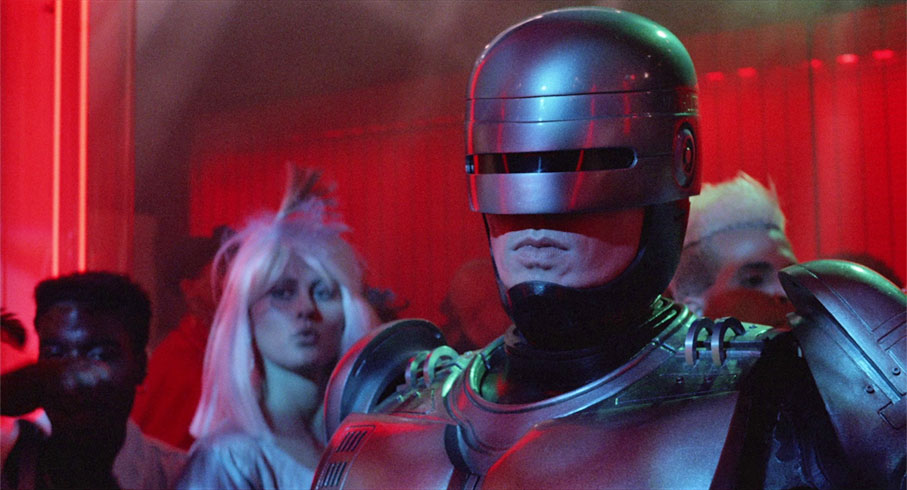
Isolated Scores
While Camus and I have been a little nonplussed about the whole concept of isolated music and effects tracks in the past, this one is – or I should say these two are – of genuine interest. Here you don't just have the option to listen to the final mix of Basil Poledouris's handsome score without the distraction of sound effects and dialogue, but also to play the film with the score as originally recorded before being mixed and edited, which includes some alternate and extended cues. I liked this one particularly, and while the final mix sounds good, the original score sounds terrific, with no variation in volume to make way for dialogue, and music cues where there are none in the final mix.
Edited-for-TV version (95:16)
Both a travesty and an intermittently hilarious drinking movie, this re-edit of the film for US television viewing castrates the violence and replaces all of the even remotely strong language with silly-ass swear words designed not to offend the sort of tight-arse puritans who shouldn't be watching RoboCop anyway. And this really is hopelessly daft stuff, with 'fucking' replaced by 'freaking', 'asshole' by 'dipstick', 'shut the fuck up and do it' with 'shut your face up and do it', 'you are gonna be a bad motherfucker!' to 'you are gonna be a bad mothercrusher!" When RoboCop interrupts the store robbery on his first night out, a disbelieving 'Fuck me!' is dismayingly transformed into a whiney plead of 'Why me?' Once again I was reminded of that Harry Enfield/Paul Whitehouse sketch in which a fictional Martin Scorsese film is "specially ruined for television." In case you've not see it, here's a link: https://www.dailymotion.com/video/x2mf7mn. A shot containing brief nudity in the police station locker room has been substituted for one that must have been shot with a TV version in mind in which the flesh in question has been covered up, and to add insult to injury, the 1.85:1 aspect ratio has been cropped to 4:3.
Complimenting this is RoboCop: Edited For Television (18:35), a brand new compilation of alternate scenes from two edited-for-TV versions, which includes outtakes newly transferred in HD from recently-unearthed 35mm elements. This works best when you know the film well enough to recognise the altered elements, but some of the dialogue substitutions are highlighted anyway by a noticeable shift in sound quality and/or tone of voice.
For those who don't know the film well enough to easily spot the differences, there are two Split Screen Comparisons that directly compare the altered elements of different versions, specifically Theatrical vs Director's Cut (4:02) and Theatrical vs TV Cut (20:16). The massive difference the running times of those two extras should give you an idea just how many changes were made for the TV version. Amusingly, 'scumbag', which was changed to 'sleazebag' in the Edited-for-TV version above, becomes the even funnier 'crumbag' in this alternate TV cut. What the fuck is a crumbag?
Not available for review until my release copy arrives is a lovely-looking 80-page Limited Edition Collector's Booklet featuring new writing on the film by Omar Ahmed, Christopher Griffiths and Henry Blyth, a 1987 Fangoria interview with Rob Bottin, and archive publicity materials. Similarly unavailable for review is a Double-Sided Poster, Six Collector's Postcards and a Stick-on Label warning potential criminals that your property is protected by RoboCop.
I sometimes think I shouldn't review favourite films, as I spend too long on them and miss release dates as a result, then get twitchy because there are always things I wanted to say that I didn't include. To modify a famous phrase about creating artwork, a review of this sort is never finished it's just abandoned. What else is there to say? A favourite film gets a dream Blu-ray release with a fabulous transfer and enough extra features to keep you busy for a week and that will teach you everything you could possibly want to know about the film, and then some. It's a brilliant package, and after going through the review discs in detail, I immediately ordered the commercial release, as the Limited Edition of one of those Arrow packages that ensure we'll never fall out of love with this distributor. Highly recommended.
|